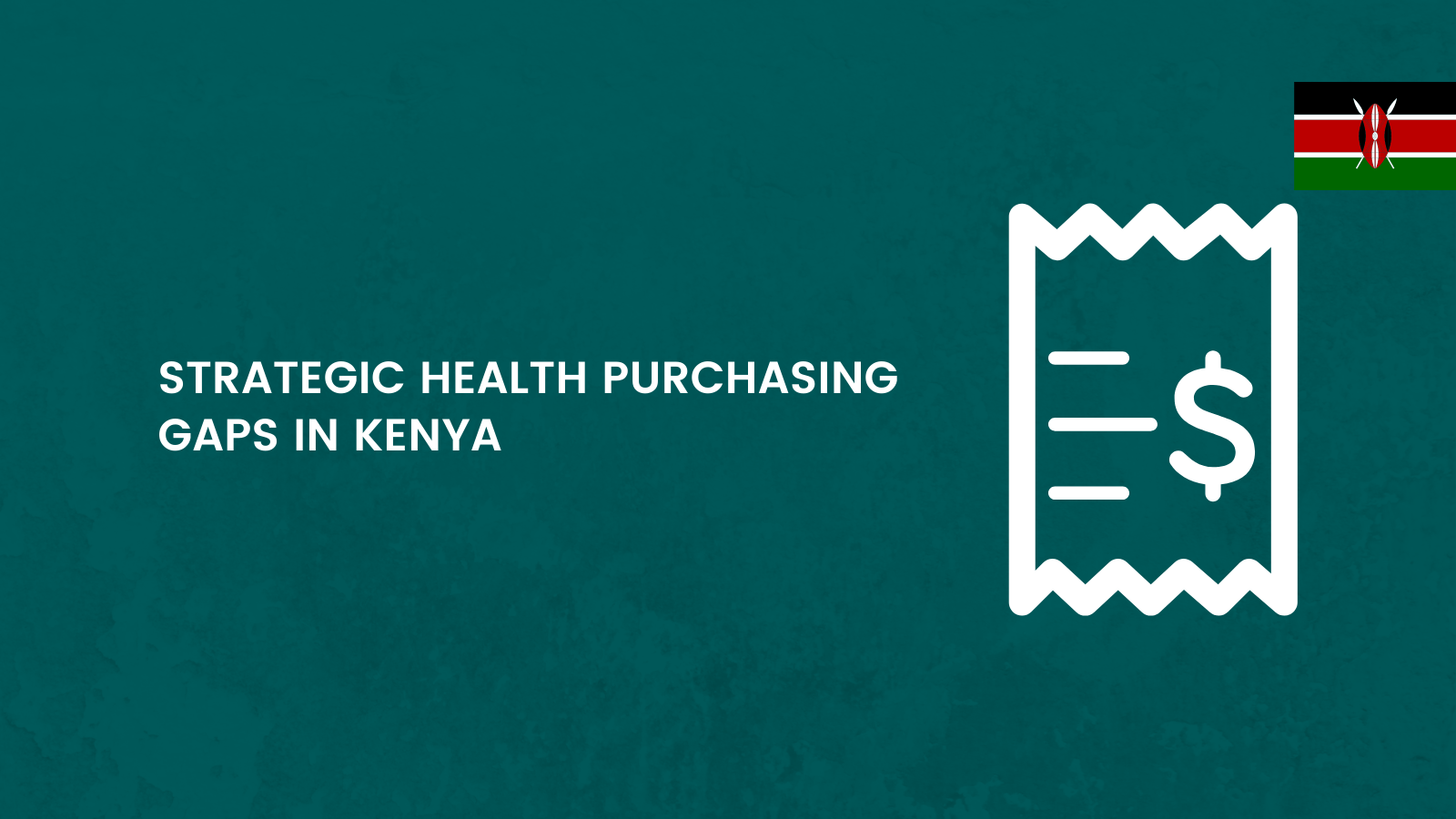Strategic purchasing remains a key reform area for advancing progress towards universal health coverage (UHC). While strategic purchasing requires a continuous pursuit for better ways to determine service entitlements, the set of providers to buy from and ways to reimburse providers, the execution of these actions remain marred with several bottlenecks in Kenya. This blog summarizes findings from a recent analysis of Kenya’s progress and gaps in strategic Health purchasing. Examined gaps are across four areas: benefits package, provider identification and selection, governance arrangements and Information systems.
Benefits package: The benefits package development and implementation process in Kenya has two main gaps. First, Kenya is yet to institutionalize a transparent and evidence-based benefits package development process. Although a Health Benefits Advisory Panel had been established to review/develop a benefits package for the UHC scheme, its term expired in June 2020. Having such an institution would permit timely and periodic review of health technologies, services, and procedures using standard criteria and processes that are transparent, involve all stakeholders and are reproducible. Second, purchasers still have multiple-fragmented benefits packages across different schemes. For example, the National Hospital Insurance Fund (NHIF) continues to operate over 70 different schemes with several fragmented benefit packages.
Provider identification and selection: While purchasers are required to actively identify and contract with a set of providers based on explicit criteria that meet strategic purchasing goals such as equity and quality of services offered, the provider identification and contracting has several gaps. First, only the NHIF engages in selective contracting, mainly with private healthcare providers but not public providers. While selective contracting could be leveraged as a cost-containment and/or performance enhancement mechanism, the approach is largely not well adopted by purchasers in Kenya. The identification and selection functions are poorly defined among the other two purchasers, the county department of health (CDOH) and the Ministry of Health (MOH), partly because they own and operate many of the facilities from which they purchase health services. This, therefore, may hinder action against poor performing facilities and does not guarantee a citizen’s access to service entitlements. Second, there remain capacity gaps in monitoring and enforcing contractual terms. For instance, although NHIF is required to conduct periodic monitoring of facilities to ensure adherence to contractual agreement, there is a lack of adequate capacity to implement this role. The slow progress further exacerbates this to institutionalize accreditation, quality assurance and inspection as part of monitoring.
Governance arrangements: Having clear frameworks and accountability mechanisms is crucial to strategic purchasing. There are three major issues in Kenya’s governance arrangements among the three purchasers (NHIF, MOH and CDOH). First, the health ministry’s oversight of the NHIF and vertical programs that purchase healthcare services on its behalf is insufficient and ineffective. Second, there are insufficient links between MOH policies and the NHIF to allow for effective management and oversight. The Ministry of Health, for example, does not recognize the NHIF as a strategic purchaser of healthcare services in Kenya, nor does it define the NHIF’s purpose clearly. Third, the NHIF’s accountability to the government appears to favour financial accountability over operational accountability. As a result, while the government has clear processes to hold the NHIF accountable for financial concerns, it does not have clear mechanisms to hold the NHIF accountable for strategic purchase goals.
Gaps in Information systems: First, Kenya currently lacks a centralized national database that can be used for clinical decision-making, facility performance monitoring, and system-level analysis of hospital performance. This impedes effective service delivery, evidence-based budgeting, and facility performance monitoring. Second, purchasers lack specific communication strategies and channels to engage both providers and patients/beneficiaries. While NHIF advertising on Supa Cover (one of the NHIF schemes) has increased, there are still flaws in user communication (e.g., about entitlements, responsibilities, and key processes) and communication modes (such as television and social media) that favour the wealthy and those living in urban areas.
As a result, while strategic purchasing remains a key reform area that can be leveraged to move Kenya closer to UHC, the country’s current deficiencies prevent it from making the necessary progress. In Kenya, institutionalizing a health technology assessment body to create defined criteria for inclusion and excluding technologies through transparent, evidence-based, and inclusive processes could be low-hanging fruit in addressing these deficiencies. Furthermore, purchasers in private and public sectors can completely execute selective contracting by precisely defining contractual criteria. Additionally, there is a need to strengthen the capacity of the ministry of health to execute its oversight role effectively. One such way may be to improve its human resource base.
Additionally, there is a need to strengthen the capacity of the ministry of health to execute its oversight role effectively. One such way may be to improve its human resource base. In addition, the country’s information system should be improved, with automated systems for claim management, effective communication, a medical records database, and systems that allow data from both the public and private sectors to be integrated.
AUTHORS

Jacob Kazungu is a Health Economist and Research Officer in the Health Economics Research Unit at the KEMRI-Wellcome Trust Nairobi programme. His current research focuses on health financing, equity analysis in healthcare, economic evaluation of healthcare interventions, the economics of sex work and using stated and revealed preference methods to improve health systems in Kenya and Sub-Saharan Africa.


Great content! Keep up the good work!
Really interesting article. I’m over simplifying here but could providers be co-opted into providing their costs of delivery, then purchasers/commissioners work out the average cost of delivery across the board & apply uplifts for higher population/living costs for urban areas to cover the premiums of being in urban areas? Potentially roots out corruption